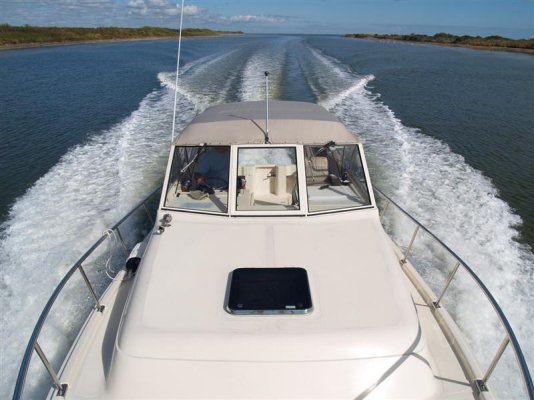- Joined
- Oct 1, 2007
- Messages
- 7,331
- Location
- Texas
- Vessel Name
- Floatsome & Jetsome
- Vessel Make
- Meridian 411
We had taken the boat out since it was fairly warm out.* A couple(frends of ours) came along with us.* The rain was coming at some point though.* We rafted up with some other friends and had a nice visit.* Dark was coming and the rain had mostly come and gone so we were ready to get moving.* Due to the rainy grey weather that was now upon us, there was only one other boat out on the whole lake(Clear Lake) other than Troy who we were rafted up to and was pretty far behind us.* We were headed down a channel that "T"s into another channel.* Of course, the only other boat on the whole body of water is converging on that intersection perfectly at the point where we will meet them(I think God does this just to mess with us).* SO I back off the speed and let the guy go ahead.* It is a 40 something sportfish doing about 10-11kts....nice wake.* SO I hang back for abit but am getting impatient so I push the power up to pass the guy.* What does he do....he pushes the power up as well just like the dumbazz in the car that does the same thing when you try to pass them.* So I figure I will come off the power and let him go to allow some spacing between us and then it won't be an issue.* But what does this dude do....he slows down also.* SO I get on the radio and try to coordinate a pass.* Of course, like about 95% of pleasure boaters in this area they don't have their radio on.* So I push the power up to go around and damned if this dude doesn't do the same and at this point I am pizzed.* So I just firewall it.* He is probably doing about 16-18kts and we are doing about 21kts(fast as my boat will go) and end up overtaking him.* Would not have been that big of a deal except when we "fell off" his wake on the pass, my boat lurched to one side and caused one of my crew to slide off her seat and fall to the deck.* She is fine and we still had a good time but will most likely have a bruise to show for it.
I will admit, it did get personal.* I was going to pass this dude....period.* And that is not good judgement.* I could not have gone outside the channel to the South since there was not enough water.* I most likely could have gone to the North but the water is skinny at that point(bout 4ft) but I could still get by in it.* I should have just stopped and reassessed but I was agitated.* Anyway, no big deal but I am pretty down on myself that I allowed this situation to get under my skin so badly.
FYI, semi-displacement hulls do not do that well at more than "semi-displacement" speeds.* The flat aftersections start producing too much lift and causes the bow to lower to the point where it starts trying to steer the boat.*** The boat actually starts trying to plane on the forward*SIDES(any lifting surface)*of the*boat and it*is usually the side that favors the torque of the prop.*Mainship options a bigger engine in this boat and it is somewhat of a waste of power and money and fuel since there is no need/desire to cruise at apeeds above 17-18kts which is where this phenomenon starts to show up.* Mainship has started to go to truer planing hulls on some of their newer boats because of this(as has Grand Banks if ya didn't know).* But a semi-dispalcement hull is magical*in the chop......and the Pilots are still Semi...
I will admit, it did get personal.* I was going to pass this dude....period.* And that is not good judgement.* I could not have gone outside the channel to the South since there was not enough water.* I most likely could have gone to the North but the water is skinny at that point(bout 4ft) but I could still get by in it.* I should have just stopped and reassessed but I was agitated.* Anyway, no big deal but I am pretty down on myself that I allowed this situation to get under my skin so badly.
FYI, semi-displacement hulls do not do that well at more than "semi-displacement" speeds.* The flat aftersections start producing too much lift and causes the bow to lower to the point where it starts trying to steer the boat.*** The boat actually starts trying to plane on the forward*SIDES(any lifting surface)*of the*boat and it*is usually the side that favors the torque of the prop.*Mainship options a bigger engine in this boat and it is somewhat of a waste of power and money and fuel since there is no need/desire to cruise at apeeds above 17-18kts which is where this phenomenon starts to show up.* Mainship has started to go to truer planing hulls on some of their newer boats because of this(as has Grand Banks if ya didn't know).* But a semi-dispalcement hull is magical*in the chop......and the Pilots are still Semi...

